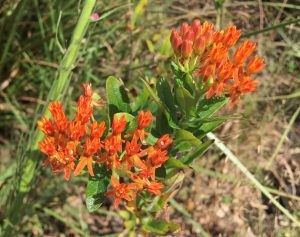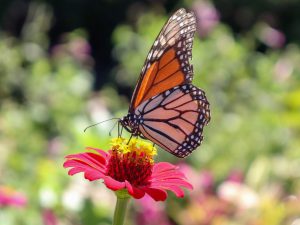Florida is home to nearly 200 species of butterflies. Attract butterflies to your garden by planting a variety of larval host plants for caterpillars and nectar plants for adult butterflies. Butterflies are entertaining to watch and help pollinate our flowers and fruits.
Creating Habitats for Butterflies

First choose the site for planting. It must have sun and access to water. Plant your garden near your patio or kitchen window where you can enjoy the visiting butterflies, bees, and hummingbirds. You can start a butterfly garden with only one plant, such as the milkweed, that is both a larval host plant and the flowers provide nectar for adult butterflies. However, a larger area of 10′ x 10′ is better so you can increase species diversity of the plants and butterflies you attract. Plant a variety of heights so there are groundcovers, small plants, shrubs and even trees if you have space. This will create a welcoming habitat for butterflies.
Selecting Plants for Butterflies

Butterflies need two types of plants to complete their life cycle. Butterfly larvae (caterpillars) need larval host plants to provide food for caterpillars. Once caterpillars eat and get big, they go through a process of metamorphosis and transform into a butterfly. Adult butterflies feed on flower nectar. Visit Table 7 of the EDIS publication Butterfly Gardening in Florida for an extensive list of Florida native butterfly nectar plants. Common nectar plants include pentas, lantana, sunflowers, zinnias, cosmos, tickseed, black eyed Susan, goldenrod, and marigolds. For a quick list with pictures, visit Perfect Plants for Pollinators. Remember bees and hummingbirds like most of the same plants.
Butterflies and their Larval Host Plants
Monarch butterflies love milkweed plants (Asclepias spp.). There are many native and non-native species of milkweed that grow in Florida. Visit our blog on Milkweed Species for Central Florida for more information. Monarch caterpillars eat the leaves of the milkweed plants and adult butterflies can eat nectar from the milkweed flowers.

Gulf fritillary and zebra longwing butterflies both use passionvine as larval host plants to rear their caterpillars. There are nearly 500 species of passionvine in the world. Go with the Florida native species such as the purple passion vine (Passiflora incarnata), corky stem passionvine (Passiflora suberosa) and yellow passionvine (Passiflora lutea). Read more about passionvine species in Florida on UF/IFAS Gardening Solutions.
There are 10 species of swallowtail butterflies in Florida and each species of swallowtail uses different larval host plants that include wild lime, wild cherry, magnolias, tulip tree, pond apple, pawpaw and parsley to name a few. The giant swallowtail is the largest butterfly in Florida. Watch our Florida Butterfly Gardening webinar recording for more information on common butterflies and plant species to attract them.
Want to learn more? Check out horticulture classes offered by UF/IFAS Extension Orange County on Eventbrite. Read about Florida-Friendly Landscaping™. Follow us on Facebook, Instagram, and visit our website at https://sfyl.ifas.ufl.edu/orange/home-lawns-landscapes-and-gardens/florida-friendly-landscaping/.
 9
9
